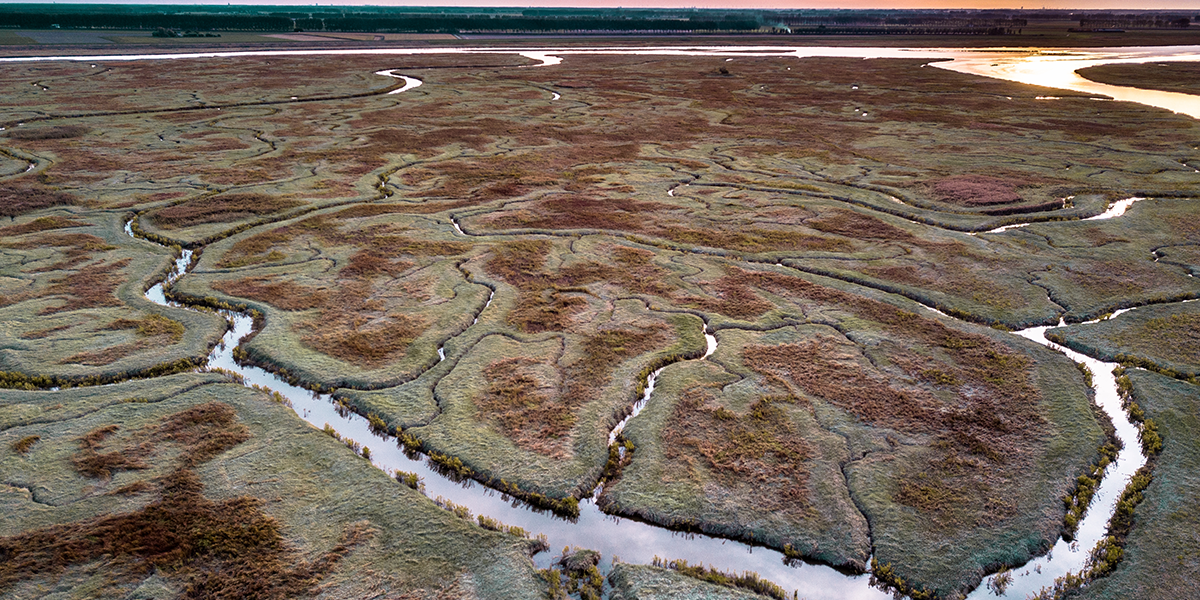Defending our coast
Coastal systems are under increasing threat by sea level rise. We will develop models to understand and predict critical transitions in coastal ecosystems, being tidal flats, salt marshes, and coastal reed- and peatlands in response to the rate of sea level rise. For this, we will build a novel high-resolution numerical model that is able to upscale small-scale bio-geomorphological processes (<1 m) to the scale of entire coastal ecosystems (>10 km). Model results will be compared with databases of coastal marsh development worldwide. This will allow us to identify characteristic changes in observed spatial patterns that can indicate changes in the resilience of coastal ecosystems, to optimally manage and strengthen coastal ecosystems facing sea level rise.
|
|
|
We will use the latest computing techniques to develop models of whether and how coastal ecosystems can adapt to sea level rise. |
| Johan van de Koppel, Gabriele Keller |

Project Team

Project description
Vegetated coastal ecosystems have a crucial role in mitigating climate change. By accumulating both sediment and organic matter, and ensure swift burial of carbon under conditions that promote long-term persistence. Salt marsh growth may even outstrip sea level rise when accumulation of sediment and organic matter is sufficient, leading to freshwater conditions becoming prevalent, and stimulating the development of estuarine reed- and peatlands. This process boosts carbon accumulation and is found to increase elevation at a rate of up to 30 cm per 30 years (1). This landscape-altering transition has led to the development of the extensive coastal fen and bog systems that have covered the European coasts (e.g. in Belgium, UK, the Netherlands and Germany) for thousands of years, accumulating almost 2 Gton of carbon, capable of lowering the global atmospheric CO2 concentration of up to 1 ppm (2).
A crucial prerequisite for this coastal sediment and carbon accumulation to persist is that the rate of vertical growth of the landscape exceeds the rate of sea level rise. Coastal wetlands may drown if the rate of elevation increase is too slow, and thereby a tipping point could be reached, which will lead to concurrent loss of much of the carbon that is stored in them. This so-called “rate tipping” assumes that ecosystem persistence is determined by the balance of the rate of environmental change and the rate of compensation (e.g. elevation increase) of ecosystems. Estuarine peatlands may not be able to compensate when increasing incursion of saltwater and (human-induced) drainage leads to their collapse despite their high elevation, as has occurred throughout the Holocene in the North Sea basin. Understanding and recognizing this rate-induced loss of coastal wetland is of major importance for both the management of coastal ecosystems and for our ability to restore the marshes and wetlands worldwide that can help absorb the carbon emitted by the global human society.

Transitions between coastal ecosystems as alternative states driven by changes in drainage structures
An important determinant of the accumulation of sediment and organic matter in salt marsh ecosystems is the efficiency of its drainage creeks. In salt marshes, flood water needs to be efficiently distributed over the marsh for sediment to disperse effectively. During ebb tide, fast drainage of the tidal water ensures optimal growth conditions for the vegetation, optimizing marsh resilience. During the transition to the reed- and subsequent peatland phase, wetlands shift into an alternate drainage regime, where water drainage decreases dramatically (figure 1). We hypothesize this process reduces the loss of rainwater and allows the accumulation of freshwater, which is crucial for the development of reed-dominated wetlands, and finally raised peatlands.
In this project, we aim to build a model of the self-organized dynamics of drainage systems in coastal wetlands ecosystems to 1) gain understanding of and 2) develop an indicator system for rate-induced critical transitions between tidal flats, salt marshes, and coastal freshwater reed- and peatlands. We will consider both “collapse” transitions between freshwater wetlands, salt marshes and tidal flats in response to sea level rise, as well as “emergence” transitions, when coastal reed and peatlands develop from salt marshes, and salt marshes from tidal flats, amplifying carbon accumulation, which is globally found in the paleorecord. Our indicator system, based on the shift in drainage properties, will help to recognize the above transitions when they occur in current-day coastal ecosystems. It will be based on patterns in salt/reed/peat vegetation and in biofilms found on tidal flats, as well as the complexity and efficiency of the drainage network formed by the tidal creeks, which are crucial for determining the resilience of both salt marshes and the emerging reed- and peatlands.
References:
(1) Reijers, V. C., et al (2019). Journal of Applied Ecology, 56(7), 1817-1826.
(2) Erkens, G., et al (2016). Hydrogeology Journal, 24(3), 551-568.
Read more +
Connected themes
- Our Dynamic Coasts
